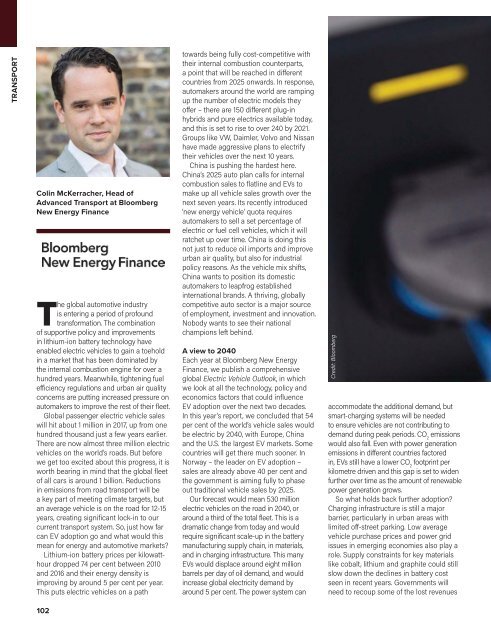Climate Action 2017-2018
Create successful ePaper yourself
Turn your PDF publications into a flip-book with our unique Google optimized e-Paper software.
TRANSPORT<br />
Colin McKerracher, Head of<br />
Advanced Transport at Bloomberg<br />
New Energy Finance<br />
The global automotive industry<br />
is entering a period of profound<br />
transformation. The combination<br />
of supportive policy and improvements<br />
in lithium-ion battery technology have<br />
enabled electric vehicles to gain a toehold<br />
in a market that has been dominated by<br />
the internal combustion engine for over a<br />
hundred years. Meanwhile, tightening fuel<br />
eff iciency regulations and urban air quality<br />
concerns are putting increased pressure on<br />
automakers to improve the rest of their fleet.<br />
Global passenger electric vehicle sales<br />
will hit about 1 million in <strong>2017</strong>, up from one<br />
hundred thousand just a few years earlier.<br />
There are now almost three million electric<br />
vehicles on the world’s roads. But before<br />
we get too excited about this progress, it is<br />
worth bearing in mind that the global fleet<br />
of all cars is around 1 billion. Reductions<br />
in emissions from road transport will be<br />
a key part of meeting climate targets, but<br />
an average vehicle is on the road for 12-15<br />
years, creating significant lock-in to our<br />
current transport system. So, just how far<br />
can EV adoption go and what would this<br />
mean for energy and automotive markets?<br />
Lithium-ion battery prices per kilowatthour<br />
dropped 74 per cent between 2010<br />
and 2016 and their energy density is<br />
improving by around 5 per cent per year.<br />
This puts electric vehicles on a path<br />
towards being fully cost-competitive with<br />
their internal combustion counterparts,<br />
a point that will be reached in diff erent<br />
countries from 2025 onwards. In response,<br />
automakers around the world are ramping<br />
up the number of electric models they<br />
off er – there are 150 diff erent plug-in<br />
hybrids and pure electrics available today,<br />
and this is set to rise to over 240 by 2021.<br />
Groups like VW, Daimler, Volvo and Nissan<br />
have made aggressive plans to electrify<br />
their vehicles over the next 10 years.<br />
China is pushing the hardest here.<br />
China’s 2025 auto plan calls for internal<br />
combustion sales to flatline and EVs to<br />
make up all vehicle sales growth over the<br />
next seven years. Its recently introduced<br />
‘new energy vehicle’ quota requires<br />
automakers to sell a set percentage of<br />
electric or fuel cell vehicles, which it will<br />
ratchet up over time. China is doing this<br />
not just to reduce oil imports and improve<br />
urban air quality, but also for industrial<br />
policy reasons. As the vehicle mix shifts,<br />
China wants to position its domestic<br />
automakers to leapfrog established<br />
international brands. A thriving, globally<br />
competitive auto sector is a major source<br />
of employment, investment and innovation.<br />
Nobody wants to see their national<br />
champions left behind.<br />
A view to 2040<br />
Each year at Bloomberg New Energy<br />
Finance, we publish a comprehensive<br />
global Electric Vehicle Outlook, in which<br />
we look at all the technology, policy and<br />
economics factors that could influence<br />
EV adoption over the next two decades.<br />
In this year’s report, we concluded that 54<br />
per cent of the world’s vehicle sales would<br />
be electric by 2040, with Europe, China<br />
and the U.S. the largest EV markets. Some<br />
countries will get there much sooner. In<br />
Norway – the leader on EV adoption –<br />
sales are already above 40 per cent and<br />
the government is aiming fully to phase<br />
out traditional vehicle sales by 2025.<br />
Our forecast would mean 530 million<br />
electric vehicles on the road in 2040, or<br />
around a third of the total fleet. This is a<br />
dramatic change from today and would<br />
require significant scale-up in the battery<br />
manufacturing supply chain, in materials,<br />
and in charging infrastructure. This many<br />
EVs would displace around eight million<br />
barrels per day of oil demand, and would<br />
increase global electricity demand by<br />
around 5 per cent. The power system can<br />
Credit: Bloomberg<br />
accommodate the additional demand, but<br />
smart-charging systems will be needed<br />
to ensure vehicles are not contributing to<br />
demand during peak periods. CO 2<br />
emissions<br />
would also fall. Even with power generation<br />
emissions in diff erent countries factored<br />
in, EVs still have a lower CO 2<br />
footprint per<br />
kilometre driven and this gap is set to widen<br />
further over time as the amount of renewable<br />
power generation grows.<br />
So what holds back further adoption?<br />
Charging infrastructure is still a major<br />
barrier, particularly in urban areas with<br />
limited off -street parking. Low average<br />
vehicle purchase prices and power grid<br />
issues in emerging economies also play a<br />
role. Supply constraints for key materials<br />
like cobalt, lithium and graphite could still<br />
slow down the declines in battery cost<br />
seen in recent years. Governments will<br />
need to recoup some of the lost revenues<br />
102












